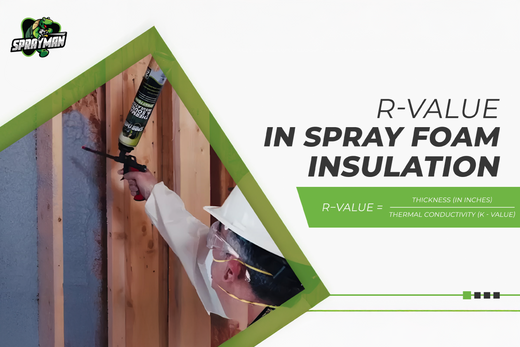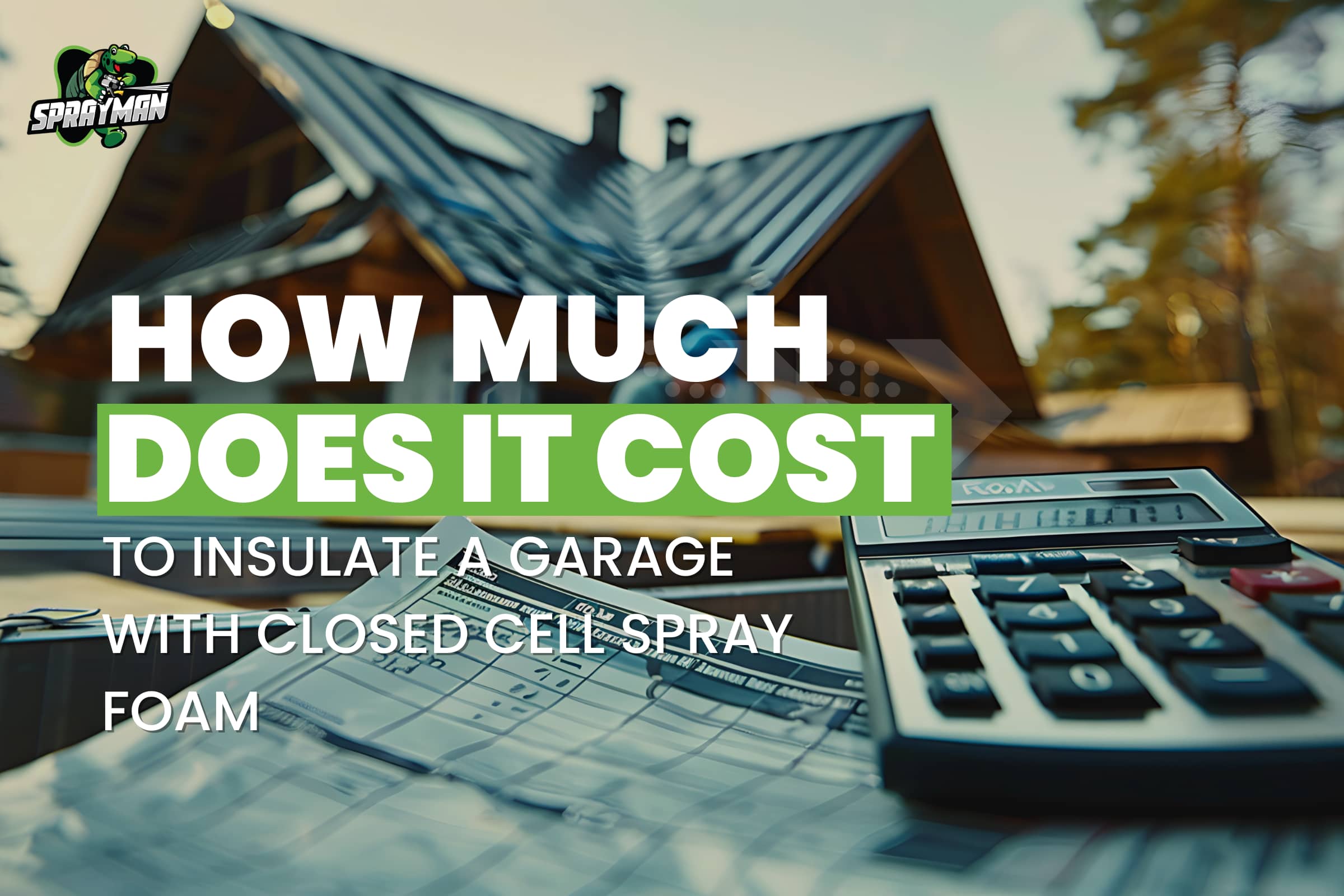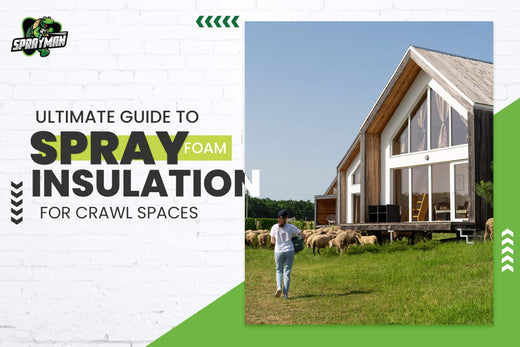Spray foam insulation R-value plays a major role in how well your home resists heat loss, maintains indoor comfort, and reduces energy consumption. Whether you're upgrading an older home or insulating a new build, understanding how R-value works is essential for choosing the right spray foam and achieving long-term efficiency. Since insulation performance varies widely between open-cell and closed-cell spray foam, knowing what influences R-value can help you avoid common mistakes and ensure you get the best results for your climate and building structure.
R-value measures how strongly an insulation material resists heat transfer; the higher the number, the better the insulation performs. With spray foam, R-value depends not only on thickness but also on density, cell structure, material composition, and installation technique. Closed-cell spray foam generally delivers higher R-values due to its rigid, tightly packed structure, while open-cell foam offers lower thermal resistance but provides other advantages, such as sound absorption and flexibility.
In this guide, we break down what R-value means, how it differs between spray foam types, the key factors that influence performance, and how to determine the right R-value for your project based on climate zone, building design, and application area. By understanding these fundamentals, you can make more informed decisions and choose insulation that delivers better comfort, durability, and long-term energy savings.

What Is R-Value and Why Does It Matter for Your Home?
R-value is a number that depicts the thermal resistance of an insulating material. It is a measure of how well an insulating material resists heat transfer. Thermal insulation is essential in homes to create comfort, prevent heat loss, and lower energy bills. The higher the number, the better the material’s ability to prevent heat transfer through conduction.
Spray foam insulation R-value represents the heat resistance for every inch of insulation applied. In essence, a recommended thickness of R-30 is achieved by applying a 5.5-inch depth of spray foam with an R6 rating.
R-value is calculated using the insulating material’s thickness and thermal expansivity. It is calculated as the ratio of the thickness of an insulating material to its thermal conductivity. Thermal conductivity is a measure of how well a material conducts heat through its mass. In other words, the R-value of a material is the thickness divided by thermal conductivity. This calculation can be made both in the metric or imperial units.
R−value = Thickness (in inches) / Thermal conductivity (k - value)
For example, we can calculate the R-value for a material with a thermal conductivity of 0.80906 BTU·inch/(hr·ft²·°F) and thickness of 12.99 inch. The R-value would be approximately 16.06.
Open Cell vs. Closed Cell: Which Type of Spray Foam Offers Better R-Value?
Closed-cell and open-cell spray foam have different thermal resistance capabilities because of their unique structure. Generally, closed-cell spray foam offers a better R-value. Closed-cell spray is composed of completely closed cells that are tightly packed. Due to its cell structure, it is highly dense and offers higher thickness than open-cell foam. The closed-cell spray foam r-value is between R5.6 to R8.
In comparison, open-cell spray foam is composed of loosely packed cells. They are less dense and lighter than closed-cell foam insulation. The open-cell spray foam's R-value is R3.6 per inch thick.
Understanding the open-cell vs closed-cell debate is crucial to choosing the right spray foam. For better air barrier and moisture resistance, closed-cell spray foam is preferred over open-cell. Closed-cell spray foam offers better structural properties such as R-value and density. Thus, they are ideal for insulating cold climates and areas prone to flooding.
What Factors Affect the R-Value of Spray Foam Insulation?
3 major factors affect the spray foam insulation R-value. They include density, thickness, and type of spray foam insulation. These factors also affect the overall effectiveness of spray foam insulation.

How Does the Material Composition Impact the R-value of Spray Foam Insulation?
The two main chemical components of Spray Polyurethane Foam are polyol resins and isocyanate. These chemicals are mixed in the right proportion to produce an effective spray foam product. The ratio and quality of these chemicals can impact insulation properties. Therefore, if the formulation favors the production of closed-cell structures more than open-cell structures, then a high R-value product is created and vice versa.
A typical scenario of how material composition impacts R-value is the formulation of closed-cell spray foam. The production of spray foam insulation thickness R-value as high as R5.6 to R7 involves adding blowing agents. Blowing agents are added in the formulation of closed-cell spray foam to create gas within the foam, leading to a rigid and dense structure.
Why Is the Density and Cell Structure of Spray Foam Critical for Its R-value?
Cell structure and density are essential factors that are critical to spray foam insulation's r-value. Cell structure determines the density and strength of spray foam. A tightly packed cell structure such as closed-cell spray foam reduces heat transfer significantly. The increased density due to the cell structure causes a higher R-value. On the other hand, loosely packed cells with tiny spaces, such as open-cell spray foam, are light and less dense.
Here is how spray foam's density and cell structure are critical to its R-value; a 2-inch closed-cell spray foam r-value is between R12 - R14. On the other hand, 2-inch open-cell spray foam offers an R-rating of R7. It is better to use closed-cell spray foam to achieve a high R-value insulation.
How Do Thickness and Application Technique Influence Spray Foam Insulation's R-value?
Spray foam insulation r-value is directly proportional to its thickness. The thicker the insulation, the higher the R-value. Typically, 3 inches of closed-cell spray foam provides a higher R-value than a 2-inch thickness.
Regarding the application technique, the R-value is directly proportional to the correct application. Application techniques influence spray foam insulation’s ability to resist heat transfer. Improper application of spray foam compromises the effectiveness of insulation. Spray patterns, layering methods, surface preparation, and environmental conditions at the time of application are some techniques that can reduce the effectiveness of spray foam insulation. That said, hiring a professional contractor ensures effective spray foam insulation installation.
Consider the insulation for wall frames; closed-cell spray foam r-value 2x6 wall has a rating of R19 - R20. In contrast, closed-cell spray foam r-value 2x4 wall is R13 - R15. Both wall frames differ in wall thickness and can accommodate a different amount of insulation. Unlike 2x4 walls, 2x6 wall frames can accommodate more insulation, offering a higher R-value.
How to Choose the Right R-Value for Your Insulation Project?
Choosing the right R-value for your insulation project is essential to ensure maximum energy efficiency and comfort at home. There are four (4) vital factors to consider when selecting the right R-value for your insulation. These factors include geographic location, building design, area of application, and local building codes. Here is how you can go about it:
1. Assess Your Geographic Location:
The location of your building will determine the amount of R-value needed to keep your space warm and comfortable. The location of your building in this context refers to the climate. According to the Department of Energy, different climate zones in the US have varying R-value requirements. Locate your climate zone using the map below.

Image sourced from the U.S. Department of Energy’s Energy Saver insulation guide.
2. Determine the Area of Application:
After finding your climate zone, the next step is to determine the part of your building to be insulated. Then check the minimum recommended R-value based using the spray foam insulation R-value chart.
Here is a table showing the recommended R-value for different parts of a building:
|
CLIMATE ZONES |
UNINSUL. ATTICS |
UNINSUL. FLOOR |
CRAWL SPACE |
BASEMENT WALL |
|
1 |
R30 - R49 |
R13 |
R13 |
R11 |
|
2 |
R49–R60 |
R13 |
R13 - R25 |
R11 |
|
3 |
R49–R60 |
R19 |
R13 - R25 |
R11 |
|
4 (except marine) |
R60 |
R19 |
R25 |
R11 - R25 |
|
4 marine & 5 |
R60 |
R30 |
R25 |
R11 - R25 |
|
6 |
R60 |
R30 |
R25 |
R25 |
|
7 & 8 |
R60 |
R38 |
R25 |
R25 |
3. Check Local Building Codes:
Local climate and environmental conditions are key factors that building codes take into account when specifying the recommended insulation requirements. Ensuring that the insulation project adheres to these building codes is essential for compliance.
4. Consider Building Design:
Wall thickness, ventilation, building orientation, and roof design are building designs that must be considered when choosing R-value. For instance, thick walls do not need as much insulation as thin walls. In addition, the type of material used in construction plays a role in determining the R-value needed for maximum comfort.
How Does Spray Foam Insulation's R-Value Improve Energy Efficiency?
Improving energy efficiency is one of the significant benefits of installing spray foam insulation. Spray foam insulation R-value is enough to reduce the workload on your HVAC system. Precisely, spray foam insulation reduces HVAC sizing by 35% while maintaining comfort and efficiency in your building.
Spray foam insulation creates an air seal in buildings, reducing air infiltration by sealing leaks. This results in a significant reduction in energy consumed by the HVAC system to keep the building cool.
What Are the Long-Term Savings Associated with High R-Value Insulation?
Installing high R-value insulation such as closed-cell spray foam means better thermal insulation. High R-value insulation reduces energy consumption in your home significantly, thereby saving money on energy bills. The money spent on installing the insulation is recovered in no distant time.
High R-value insulation improves the lifespan of your HVAC system. A properly insulated home puts less strain on the HVAC system. Insulation reduces the constant need to heat or cool. There is less need for regular repairs, thereby maintaining efficiency and improving lifespan.

FAQs
Why Is R-Value Important When Calculating Spray Foam Insulation Costs?
R-value directly affects insulation performance and cost. Higher R-values require more material, increasing expenses. For a detailed cost analysis, visit our Spray Foam Insulation Cost Guide.
How many Inches of Spray Foam Insulation Do I Need?
The thickness depends mainly on the application area and the type of spray foam. For optimal insulation, 2–3 inches of closed-cell spray foam is typically required for walls, while 4–5 inches are applied on roofs. Open-cell spray foam requires greater thickness. For roofs, open-cell spray foam is usually applied at 6–10 inches.
What Are the Different Types of Spray Foam Insulation?
There are two distinct types of spray foam insulation; closed-cell and open-cell spray foam insulation. Learn more about the specific types of spray foam insulation, including open-cell and closed-cell options, in our detailed comparison guide on "Find Your Ideal Type of Spray Foam Insulation: Open vs. Closed Cell Explained."
Does Spray Foam Insulation Lose Its R-value?
Spray foam insulation R-value does not decline over time. When properly installed, spray foam is highly durable and can maintain its durability over a long period.
What Is the R-value of a 2x6 Wall with Spray Foam?
The recommended R-value for a 2x6 wall is R19 - R21. 2x6 wall frames are ideal for cold areas because they offer space for additional insulation.
How Does the R-Value Relate To Soundproofing in Spray Foam Insulation?
High R-value insulation provides soundproofing capabilities by reducing sound transmission. The minimum R-value required in residential buildings for soundproofing is R13 - R19. In addition, open-cell spray foam offers inherent soundproofing abilities by absorbing sound waves.
Is There a Connection Between R-Value and Air Leakage in Insulation?
R-value has no significant connection with air leakage in insulation. A high R-value building can still experience poor energy efficiency when it is not properly air-sealed. To achieve optimal performance, both high R-value insulation and effective air sealing are necessary, but they address different aspects of a building's thermal envelope.




Leave a comment
This site is protected by hCaptcha and the hCaptcha Privacy Policy and Terms of Service apply.